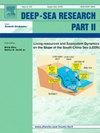利用CMIP6地球系统模式模拟了解印度洋叶绿素-a的未来变化
IF 3
3区 地球科学
Q2 OCEANOGRAPHY
Deep-sea Research Part Ii-topical Studies in Oceanography
Pub Date : 2025-01-12
DOI:10.1016/j.dsr2.2025.105458
引用次数: 0
摘要
本研究利用耦合模式比对项目第6阶段(CMIP6)地球系统模式模拟输出和基于卫星的叶绿素-a (Chl-a)观测资料来了解印度洋最近一段时间以来Chl-a浓度的变化及其未来变化。基于三种未来情景(SSP5-8.5、SSP2-4.5和SSP1-2.6)的通用模型的可用性,我们选择了11个CMIP6模型进行本研究。根据基于卫星的海洋颜色气候变化倡议第5版(OC-CCI-V5)数据产品对这些模式模拟的历史输出的气气学进行了评估。将印度洋(IO)划分为四个区域(阿拉伯海(AS)、孟加拉湾(BoB)、中印度洋(CIO)和南印度洋(SIO)),并在印度洋的每个区域对每种CMIP6模型的性能进行了评估。根据统计分析,发现GFDL-ESM4是所有四个IO区域中性能最好的模型。然而,GFDL-ESM4低估了AS和CIO区域的Chl-a浓度(>;0.07 mg/m3),而高估了BoB区域的Chl-a浓度(<;−0.07 mg / m3)。GFDL-ESM4在Chl-a偏置浓度较小的SIO区表现相对较好。在SSP5-8.5情景下,未来Chl-a的变化表明Chl-a浓度将大幅下降(<;−0.04 mg/m3),在AS西海岸、BoB西海岸和爪哇南部海岸。在SSP1-2.6情景下,Chl-a浓度的大幅下降被限制在接近0.01 mg/m3。因此,实施极端减缓措施可以控制IO中表面Chl-a浓度的降低。对未来IO 6个上升流区混合层中Chl-a浓度变化的分析表明,在未来所有情景下,混合层中Chl-a浓度将降低−0.06 ~−0.09 mg/m3。本文章由计算机程序翻译,如有差异,请以英文原文为准。
Understanding future changes of Chlorophyll-a in the Indian Ocean using CMIP6 Earth System Model simulations
This study uses the Coupled Model Intercomparison Project phase 6 (CMIP6) Earth System Model simulated outputs and satellite-based chlorophyll-a (Chl-a) observations to understand the changes in Chl-a concentration in the recent past and its future changes in the Indian Ocean. Based on the availability of common models across the three future scenarios (SSP5-8.5, SSP2-4.5, and SSP1-2.6), we chose 11 CMIP6 models for this study. The climatology of these model-simulated historical outputs is assessed against a satellite-based Ocean Colour Climate Change Initiative-Version 5 (OC-CCI-V5) data product. The Indian Ocean (IO) is divided into four regions (Arabian Sea (AS), Bay of Bengal (BoB), Central Indian Ocean (CIO), and Southern Indian Ocean (SIO)), and the performance of each of these CMIP6 models are evaluated in each of these regions of IO. Based on the statistical analysis, GFDL-ESM4 is found to be the best-performing model across all four IO regions. However, the GFDL-ESM4 underestimates Chl-a concentration in the AS and CIO regions ( 0.07 mg/m), whereas it overestimates Chl-a concentration in the BoB region ( −0.07 mg/m). The GFDL-ESM4 performs relatively better in the SIO region with a less biased Chl-a concentration. Under the SSP5-8.5 scenario, the future changes of Chl-a indicate a large decrease in the Chl-a concentrations ( −0.04 mg/m) in the western coast of the AS, the western coast of BoB, and the southern Java coast. This large decrease in Chl-a concentration is limited to nearly 0.01 mg/m under the SSP1-2.6 scenario. Therefore, the implementation of extreme mitigation measures can control the reduction of surface Chl-a concentration in the IO. The analysis to understand future changes in Chl-a concentration in the mixed layer of six upwelling zones in the IO indicates a decrease in Chl-a concentration in the mixed layer by −0.06 to −0.09 mg/m in all future scenarios.
求助全文
通过发布文献求助,成功后即可免费获取论文全文。
去求助
来源期刊
CiteScore
6.40
自引率
16.70%
发文量
115
审稿时长
3 months
期刊介绍:
Deep-Sea Research Part II: Topical Studies in Oceanography publishes topical issues from the many international and interdisciplinary projects which are undertaken in oceanography. Besides these special issues from projects, the journal publishes collections of papers presented at conferences. The special issues regularly have electronic annexes of non-text material (numerical data, images, images, video, etc.) which are published with the special issues in ScienceDirect. Deep-Sea Research Part II was split off as a separate journal devoted to topical issues in 1993. Its companion journal Deep-Sea Research Part I: Oceanographic Research Papers, publishes the regular research papers in this area.

 求助内容:
求助内容: 应助结果提醒方式:
应助结果提醒方式:


